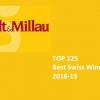Asian Market beckons for Swiss Wines
Having an old viticulture tradition that can be traced back to the Romans, the Alpine country’s winemaking is, however, often dwarfed by its neighbouring wine giants, France, Germany and Italy. With 15,000 ha (the size of Alsace) under vine, its vineyards are spread across six main regions – Vaud, Geneva, Three Lakes and Valais in French Switzerland in the west and southwest, German-speaking Switzerland in the north and east and Ticino bordering Italy.
By Natalie Wang from The Drinks Business
Vaud, a French speaking Canton near Lake Geneva, was the sole focus at a Swiss wine tasting organised by Hong Kong’s Swiss wine importer, Swiss Wine Shop, and its wine trade organisation, Office des Vins Vaudois (OVV), this week in Hong Kong. Producing about 25% of the country’s total wines, the region is home to a UNESCO site, Lavaux, an area known for its beautiful, terraced vineyards.
The majority of its wines are consumed domestically and less than 2% of the wines are exported. Trailing behind Germany and the UK, Asia has slowly emerged on the map after Swiss wines were first exported here a few years back, Benjamin Gehrig, project manager of OVV, told dbHK.
Speaking of Vaud’s predominant white grape variety, Chasselas, the trade official revealed that it is taking off in Japan, thanks to its low acidity and low alcohol level (usually just around 12%). “More than 60% of grapes planted in Vaud are Chasselas, and it has been very popular in Japan since we started exporting there,” he explained, even going further to call Swiss wine, a novelty in Asia, “the best kept secret of Switzerland”.
In Shanghai, the wine seems to be taking off as well. “Chasselas is the wine that is very fresh, open and you can pair it with any kind of food. You know how people are like in China where they eat everything on the table. It’s difficult to do a wine pairing, and Chasselas works very well even with spicy dish,” said Philippe Huser, owner of Napa Wine Bar & Kitchen in Bund, which imports about 6,000 bottles of Chasselas to Shanghai. With the whole packaging of UNESCO and Swiss image, the wine became an instant hit, he added.
Production is limited as only close to 4,000 ha are under vine in Vaud. Compared with imported French wines, due to extensive labour costs, domestic wines carry heftier price tags, said Gehrig.
“Switzerland is an expensive country. It has the most expensive entry level wine in the world, but for good quality wines, we probably have the best value for money,” commented Damien Fleury, owner of the Swiss Wine Shop, which sells around 100 different Swiss wines that average between HK$300 and HK$500. The average price for a bottle of wine bought in Hong Kong is HK$150, according to Numbeo.
“Switzerland is a country known for its quality and precision, and we have that in the wine as well. If you take French wines as an example, it has the best wines in the world, but it also has the worst wines in the world. The quality varies very much, but in Switzerland the quality is consistent,” he added.
Switzerland plants about 50 different kinds of foreign and indigenous grapes with four major grapes – Pinot Noir, Chasselas, Gamay and Merlot – accounting for about 72% of its total wine production.






